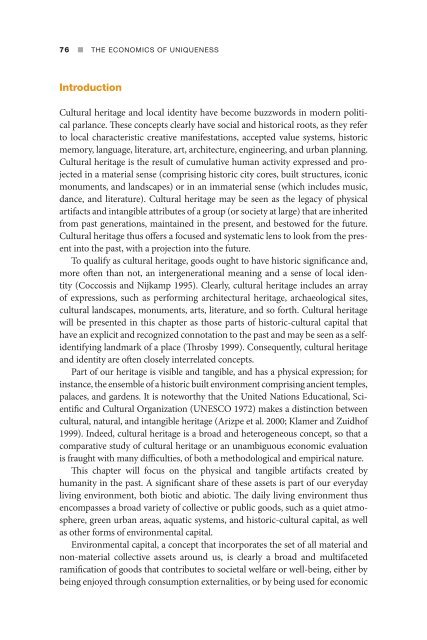ECONOMICS UNIQUENESS
ECONOMICS UNIQUENESS
ECONOMICS UNIQUENESS
Create successful ePaper yourself
Turn your PDF publications into a flip-book with our unique Google optimized e-Paper software.
76 ■ THE <strong>ECONOMICS</strong> OF <strong>UNIQUENESS</strong><br />
Introduction<br />
Cultural heritage and local identity have become buzzwords in modern political<br />
parlance. Th ese concepts clearly have social and historical roots, as they refer<br />
to local characteristic creative manifestations, accepted value systems, historic<br />
memory, language, literature, art, architecture, engineering, and urban planning.<br />
Cultural heritage is the result of cumulative human activity expressed and projected<br />
in a material sense (comprising historic city cores, built structures, iconic<br />
monuments, and landscapes) or in an immaterial sense (which includes music,<br />
dance, and literature). Cultural heritage may be seen as the legacy of physical<br />
artifacts and intangible attributes of a group (or society at large) that are inherited<br />
from past generations, maintained in the present, and bestowed for the future.<br />
Cultural heritage thus off ers a focused and systematic lens to look from the present<br />
into the past, with a projection into the future.<br />
To qualify as cultural heritage, goods ought to have historic signifi cance and,<br />
more oft en than not, an intergenerational meaning and a sense of local identity<br />
(Coccossis and Nijkamp 1995). Clearly, cultural heritage includes an array<br />
of expressions, such as performing architectural heritage, archaeological sites,<br />
cultural landscapes, monuments, arts, literature, and so forth. Cultural heritage<br />
will be presented in this chapter as those parts of historic-cultural capital that<br />
have an explicit and recognized connotation to the past and may be seen as a selfidentifying<br />
landmark of a place (Th rosby 1999). Consequently, cultural heritage<br />
and identity are oft en closely interrelated concepts.<br />
Part of our heritage is visible and tangible, and has a physical expression; for<br />
instance, the ensemble of a historic built environment comprising ancient temples,<br />
palaces, and gardens. It is noteworthy that the United Nations Educational, Scientifi<br />
c and Cultural Organization (UNESCO 1972) makes a distinction between<br />
cultural, natural, and intangible heritage (Arizpe et al. 2000; Klamer and Zuidhof<br />
1999). Indeed, cultural heritage is a broad and heterogeneous concept, so that a<br />
comparative study of cultural heritage or an unambiguous economic evaluation<br />
is fraught with many diffi culties, of both a methodological and empirical nature.<br />
Th is chapter will focus on the physical and tangible artifacts created by<br />
humanity in the past. A signifi cant share of these assets is part of our everyday<br />
living environment, both biotic and abiotic. Th e daily living environment thus<br />
encompasses a broad variety of collective or public goods, such as a quiet atmosphere,<br />
green urban areas, aquatic systems, and historic-cultural capital, as well<br />
as other forms of environmental capital.<br />
Environmental capital, a concept that incorporates the set of all material and<br />
non-material collective assets around us, is clearly a broad and multifaceted<br />
ramifi cation of goods that contributes to societal welfare or well-being, either by<br />
being enjoyed through consumption externalities, or by being used for economic


